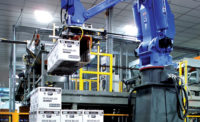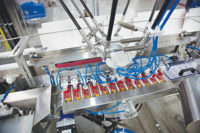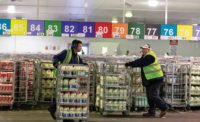Today’s stackers and loaders possess numerous qualities well-suited for today’s fast-paced production environments, such as high-speed operation, flexibility and space-saving footprints. Sophisticated controls and programming, as well as automated response to equipment failures upstream and downstream, are also common features.
The ability of stackers and loaders to handle various product shapes, sizes and materials has improved, too, in response to growth in shelf-ready packaging (SRP). “The SRP movement is calling for cases that fit on the shelf two-deep, which often results in smaller shipping sizes,” says Rick Gessler, director of marketing and strategic account management, Delkor Systems Inc., St. Paul, MN. “This can be straightforward, in some cases, but often the speeds are doubling as case counts are halved. In addition, multiformat loaders are gaining favor, and changeover times are as critical as ever.”
To address these needs, the company recently introduced a case packer for flexible pouches. The machine produces the company’s SRP, as well as other types on the market. “The compact system replaces the typical case erector, loader and sealer with one integrated cell,” says Gessler. “Automated changeover allows users to convert from one case format to another in less than 10 minutes. The combination of two Fanuc robots replaces traditional collators and hard automation with flexibility.”
The ability to handle SRP will likely continue moving forward. “We’ve seen an increase in demand for machinery to handle display-ready packaging in the last five years,” says Craig Friesen, product line manager, Thiele Technologies Inc., Minneapolis. “New case designs are being developed all the time to reduce the amount of materials used both for cost savings and sustainability. Often, these new designs necessitate a new machine capable of packing diverse products into a variety of case or tray shapes and sizes.”
Rise of the robots
The call for stacking and loading flexibility has increased demand for vision-guided, robotic, pick-and-place systems versus more traditional, gantry, robotic pick-and-place designs with collating infeed systems, according to Scott M. Reed, vice president, sales, marketing and customer service, ADCO Manufacturing, Sanger, CA. “We are seeing more all-in-one machines, which directly addresses the trend toward doing more in a smaller workspace.”
Today’s robotic systems offer performance and dependability. “Being able to eliminate collation chains, fixed pneumatic devices or servo-actuated assemblies with a highly functional robot not only reduces the number of parts and potential failure points of a packaging system, it provides greater potential for future expansion of the line,” Gessler says.
Robotics can improve stacking and loading as greater demand for new and different product formats come into vogue. “Companies are looking for ways to maximize their flexibility and ability to provide variety in their product offerings,” says Reed. “Robotics is not only flexible, it is becoming less complex and costly to deploy in many applications.”
Reed’s company recently introduced the a robotic carton loader that features a two-axis robot using a parallel kinematic design and Allen-Bradley motion controls to deliver high pick rates with few moving parts. “Because it does not utilize proprietary motion control, it is easy to program and operate,” he explains.
AMF Bakery Systems, Richmond, VA, offers an arm basket loader (ABL) featuring programmable logic controller and controlled collation of soft products at higher line speeds. Capabilities include the ability to load multiple shippers and automated changeover from product to product and/or shipper to shipper. In addition, end of arm tool (EOAT) design/programming limits the number of changeover requirements.
Schneider Packaging Equipment, Brewerton, NY, recently introduced a portable, plug-and-play, small-footprint robotic palletizer that provides an end-of-line palletizing solution for fluctuating production demands. Capable of picking, packing, assembling and loading, the robotic palletizer’s long arm can pack pallets up to 70 inches high. It easily fits into small spaces, according to Barry Rinaldi, director of business development for the company.
The flexible palletizer is also designed to handle multiple SKUs, often without mechanical changeover, and comes with semi- and fully automatic pallet exchange.
Friesen notes that his company offers robotic loading systems that handle flexible products, such as pouches and bags. The systems use end-of-arm tooling and case-handling techniques to accumulate, stack and load difficult products into cases or trays. “A robotic vision system identifies product as it arrives randomly on a conveyor and manipulates it into a uniform pattern in the case,” he says. “Servo-driven vane systems can be used, when necessary, to accumulate and organize pouches or bags before they are placed in the case.”
Stackers and loaders also must be designed to handle various product sizes, shapes and composition, and respond to environmental factors, such as temperature. “While boxes are relatively simple to stack, flexible and pouch products are inherently more challenging to pack,” says Rinaldi. “Also, many facilities that want to automate processes need to do so in their current floor space, which may be less than accommodating for larger equipment.”
Nonrobotic options
Forpak, Burnsville, MN, offers nonrobotic stacking and loading equipment, according to Pat Goche, general manager for the company. “Within the area of our competitive advantage, we often replace robotic systems, or compete with them for new projects,” he says. “Many of our customers start a project believing robotics is their ultimate solution, and many of them find they is not the true solution.
“We have added Allen-Bradley controls and servo-motor-controlled actuators for our key motions. This gives us better control and consistency within stackers and loaders. The AB controls give us the ability to respond better to events taking place throughout the production line—in areas from presentation of product, visual inspection, product rejection and accumulation due to downstream issues.”
The company also developed shingle height detection, a new stacking and loading technology. “Frozen waffles and pancakes find ways to double up or shingle on top of each other,” Goche explains. “The new system identifies these scenarios and removes the minimum number of waffles or pancakes from production. This is done by incorporating a 4-inch-wide by 24-inch-long shuttle conveyor for each product lane. Each lane has its own sensor. The product is rejected onto a conveyor that empties the product into totes or can be recycled back upstream.”
Designed for food safety
Food safety is a key consideration for equipment manufacturers when designing stackers and loaders. “Snack food and bakery producers have been asking more and more for machinery that is designed to meet sanitary guidelines for low-moisture foods,” says Reed. “With the advent of the Food Safety Modernization Act and the Global Food Safety Initiative, brand owners are advancing their own sanitary programs to ensure compliance.”
This is true across the industry, says Goche. “By far, the demand for more hygienic and sanitary equipment to comply with regulations and standards is the most acute trend identified by our customers,” he says.








